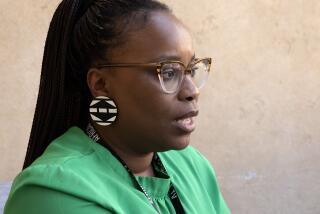Filmmaking symbiosis ... to a degree
A longtime admirer of Stan Brakhage, I knew nothing of the filmmaker’s Hollywood interlude until checking in with University of Southern California film professor David James. A leading theorist and historian of alternative cinematic practices, James recently completed a study of non-studio filmmaking called “The Most Typical Avant-Garde: History and Geography of Minor Cinemas in Los Angeles.”
According to James, non-studio filmmaking and Hollywood have long been “engaged in various kinds of dialogues and negotiations” with each other. In some cases, avant-garde filmmakers have entered the industry; more rarely, industry workers have migrated into the avant-garde. Interestingly, as James points out, the strongest collaboration between avant-garde filmmakers and those working in Hollywood occurred during the 1920s. By that time, the studios were a growth industry that, in the wake of World War I, could lure talent from around the globe, including one of Busby Berkeley’s future collaborators, Slavko Vorkapich.
“ ‘The Life and Death of 9413: A Hollywood Extra’ was made by people who had industry day jobs,” James says of Vorkapich and Robert Florey’s landmark short. “Josef von Sternberg’s first film, ‘The Salvation Hunters,’ was essentially an independent production. The 1940s were very feverish, but that was a period when -- with the increasing polarization of American society and the incipient blacklist -- avant-garde production took place almost entirely outside the industry. Maya Deren made her great film [‘Meshes of the Afternoon’] in Hollywood, but it was made with the assistance of a Central European experimental filmmaker, not with the assistance of studio professionals who had, in fact, assisted Orson Welles in his experimental film [‘Citizen Kane’] a couple years earlier.
“By the time you get to the late 1940s, all of what I think of as the Maya Deren acolytes -- Kenneth Anger, Curtis Harrington, Gregory Markopoulos -- were attempting to make experimental films on their own, separate from the industry, which is essentially a new productive position. The only people who made films separate from the industry before then were Los Angeles communists. In the 1930s, there was a very active branch of the Workers’ Film and Photo League in Los Angeles that made films on behalf of migrant workers, dockworkers and various kinds of militant social organizations. Those guys perceived Hollywood to be the real enemy -- they didn’t want anything to do with it. But every other time Hollywood has kind of beckoned.”
There have been major eruptions in off-Hollywood creativity in the years since, arguably, none as important and as lastingly influential as the African American filmmakers -- including Charles Burnett, Billy Woodberry, Julie Dash and Haile Gerima -- who came out of UCLA during the 1970s. But times change.
“I think the era of film as being the medium for emergent social groups has passed,” says James. “Emergent social groups now mobilize themselves in visual-image culture, in digital or video. They’re more likely to be involved in music than moving-image culture. But I still think the industry is very much dependent on new voices, new influences from the outside, and recognizes this and is always looking for new possibilities.”
More to Read
Only good movies
Get the Indie Focus newsletter, Mark Olsen's weekly guide to the world of cinema.
You may occasionally receive promotional content from the Los Angeles Times.










